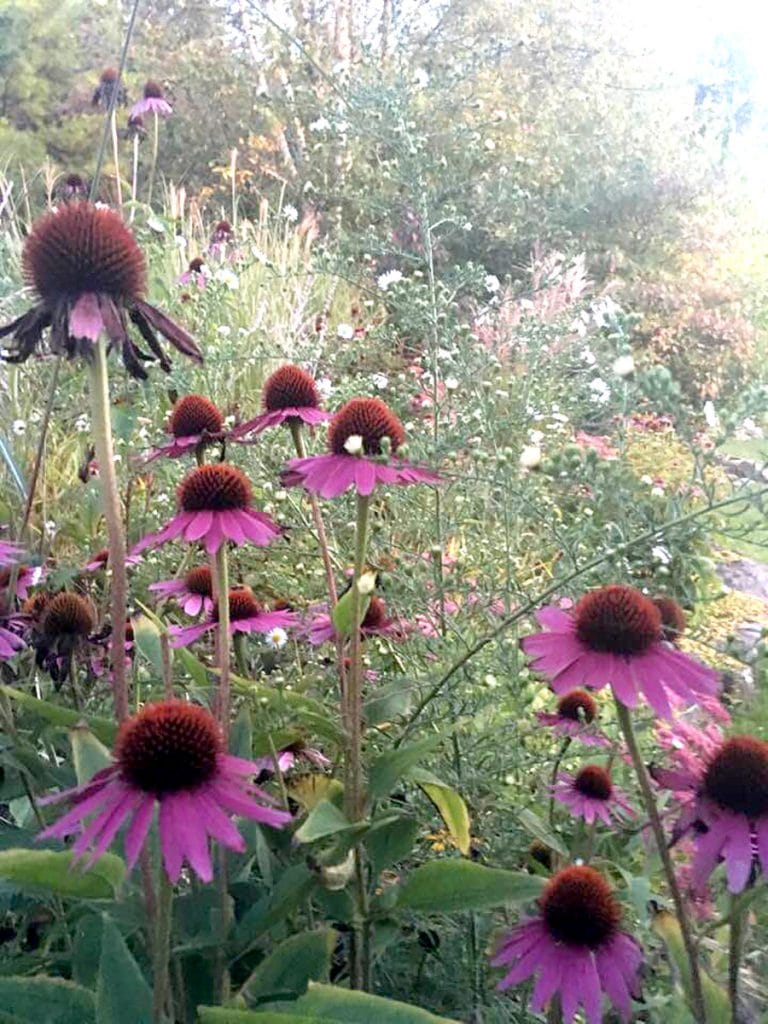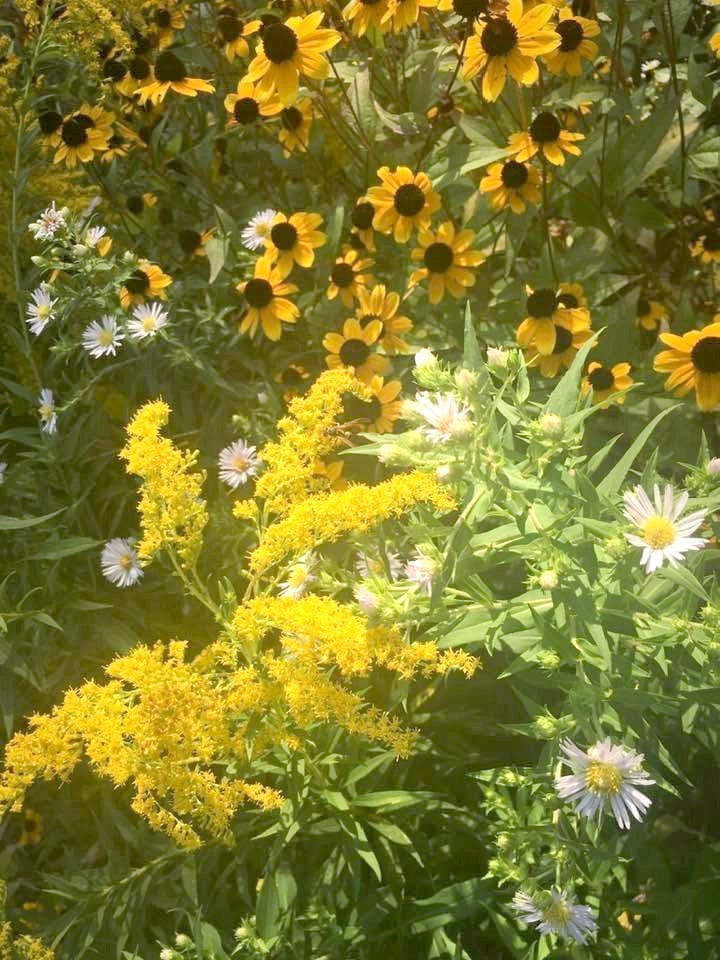WELLINGTON COUNTY – Little yellow flowers on tall cup plants buzz with bees, finches feast on seeds from purple asters, and monarch caterpillars chew milkweed leaves in naturalized gardens across the county.
Naturalized gardens are teeming with life – they provide shelter and food for insects and wildlife, enrich soil, and offer a low maintenance way to add colour and beauty to a landscape.
Former Toronto Entomologists Association president president Bipin Dhinsa said naturalized gardens are “purposely designed gardens or landscapes that incorporate native plants, wildlife friendly features and sustainable practices to create a more balanced and self-sustaining ecosystem.”
Benefits of naturalized gardens
Native plants are often drought tolerant and disease resistant, said Guelph-Wellington Master Gardener Janine Robertson, and they “adapt to the soil and sun conditions in the area that you live in – so it means a lot less work.”
Robertson said when she used to grow asiatic lilies she struggled with aphids, and when she grew roses she struggled with mould, because those plants haven’t evolved to grow in this area and are not suited to the local environment.
“Now I’ve moved on to echinacea – I can grow so many and don’t need pesticides or water.”
Growing non-native plants is like swimming upstream, she said, whereas naturalized gardens allow gardeners to “let it go, let it flow, learn what grows in your environment [and] pick things that are going to thrive.”
The best approach for issues such as unwanted insects, Robertson said, is “planting things that get along and coexist.
“We can’t use pesticides like we used to, and we shouldn’t, because you aren’t just killing the aphids, you are killing something else.”
Three Sisters gardens are a method of companion planting common in many Indigenous communities. The Three Sisters are squash, beans, and corn. Squash acts as a groundcover that blocks weeds, beans add nitrogen to the soil, and corn offers structure for beans to climb.
The transition to naturalized gardens involves learning to like the plants that naturally grow here, Robertson said.
Social norms sometimes limit what gardens are considered aesthetically pleasing – often exotic plants growing in tidy rows.
But naturalized gardens are beautiful too – Robertson points out complimentary colours often grow together naturally, such as yellow goldenrod and purple asters.
With naturalized gardens, “it’s okay to be a little bit messy,” Robertson said.
Less gardeners are cutting everything down at season’s end, she said, because winter gardens provide essential shelter and food.
“Just let it be there in the winter, for the winter insects,” she recommends.
“Let the finches come and eat the seeds of your echinacea or cup plants – let them be over the winter, and then cut them down in the spring.
“Little caterpillars and eggs nest in stalks of cup plants over winter, so if you cut them down you are losing habitat.
“As gardeners, we have a huge impact,” Robertson said.
Dhinsa said naturalized gardens are beneficial because they:
– provide education;
– mitigate climate change;
– increase crop yields;
– support insects and wildlife;
– reduce water use; and
– require little maintenance.
He said the education piece comes in when people install “pollinator friendly” signs in their naturalized gardens.
“It brings up a lot of questions when people see those signs, so it’s a great educational tool.”
Naturalized gardens mitigate climate change and improve air quality because “native plants capture and store carbon,” Dhinsa explained.
And “all crop production benefits from healthy ecosystems” primarily by increasing the populations of pollinating insects in the area. Dhinsa said crop yields increase by 30 to 40% when there are naturalized areas around fields.

Echinacea/purple cone flowers Submitted photo
Growing naturalized gardens
Robertson suggests putting in “a nice little pollinator patch” with prairie dropseed, asters, echinacea, and cup plant.
She recommends starting with a “clean slate” by pulling up any weeds in the space, noting sometimes this takes a few tries, especially with invasive plants like goutweed.
Once the weeds are gone, she advises amending the soil with triple mix or compost.
Lennox Toppin is an experienced gardener and a member of many horticultural societies and gardening clubs.
He said some people imagine starting a naturalized garden by tossing seeds haphazardly, but there’s nothing natural about that.
In natural environments, plants do not grow randomly, but in highly organized systems.
Toppin recommends gardeners go out into nature and observe the relationships between plans.
Dhinsa says once you have a clean slate, “imagine your garden as a canvas awaiting the brushstrokes of nature, as you introduce and carefully curate a selection of native plants and artful design features like water gardens, conjuring a miniature oasis.”
For an aethestically pleasing garden, “consider design principles,” Toppin recommends.
And “plant structurally, so plants don’t flop over.”
Consider the characteristics of the plants you want to incorporate, he added.
For example, only plant swamp milkweed if you have swampish conditions.
If you want to grow common milkweed – bear in mind it “works best in a kind of aggressive way, so you can’t really have one milkweed,” he added.
“Not only will it be impossible because of the way it spreads underground with its root system, but also if you are planting milkweed for the monarchs they need a colony of them.
“So unless you are prepared for a huge colony of common milkweed, that might not be something that you plant.”
Fall is a great time for planting natives and once they are established, “you don’t have to do anything,” Robertson said.
She recommends planting as close as possible.
Some popular plants in naturalized gardens may be recognized as weeds, like goldenrod and milkweed, but as Winnie the Pooh famously says, “Weeds are flowers too, once you get to know them,” Robertson quipped.
In the first years of growing Dhinsa said there will be weeds to pull, but he hasn’t picked a weed in years “because the native flowers have spread, and I have ground cover.”
Toppin, however, recommends people prepare for hefty maintenance.
“I’ve always said if you want a garden you don’t have to maintain, plant florus plasticus,” he joked – plastic flowers. “Those are the only flowers that don’t need maintenance in a home garden situation.”
Most native plants need regular watering after planting, but once settled, don’t need watering at all.
This is great during water restrictions, Robertson noted, as many gardeners struggle with “funky plants” that die without regular watering.
Robertson said the significant maintenance in established naturalized gardens tends to be thinning, as some plants will take over if left unkempt.
“Separate, divide, and share,” Robertson said.
Robertson recommends flexibility while growing naturalized gardens. “See what lives,” she said, and if some plants don’t make it, “try something else.”
Robertson tried to grow turtlehead (chelone) which didn’t survive, so she replaced them with echinacea and rudbeckia (Black-eyed Susans).
“That’s okay,” she said, “as a gardener, go with the flow and don’t fight.
“Keep your mind open and keep learning.”




